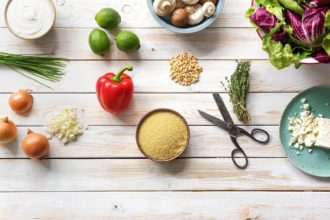A Cut Above: Knife Skills February 6, 2014
If there’s one area that most home cooks struggle with, it’s improving their knife skills. Not to worry, HelloFresh is here to help. Listed below are some of the most common knife techniques. However, before we get to that, let’s talk about knife safety. The proper way to hold a knife when you’re chopping is by choking up on the handle and making sure you have a firm grip on the blade between your thumb and forefinger, as shown below:
For the non-cutting hand use a “bear claw” grip. Think of cupping your fingers into the letter “c” shape or holding an egg. With your fingers curled back towards your thumb (and your thumb curled behind your fingers), rest your knuckles against the blade as a guide, as shown below:
For food items that are round, chop off the top and the bottom ends (this is also known as topping and tailing) to make a flat side that you can then rest on the cutting board for more control. A few other helpful tips: Always carry a knife at your side, with the tip pointing towards the floor. Stand while you cut. Always cut on a cutting board. To keep the cutting board from slipping, place the cutting board on top of a damp towel.
Chop: When a recipe calls for a “rough” chop, it means that the individual pieces of the food don’t have to all be the same shape and/ or size. To use this technique, keep the tip ofyour blade on the far side of the piece of food you’re cutting — you chop by moving your hand and wrist up and down.
Mince: Mincing is very similar to chopping – the difference being that minced foods are chopped very finely so they can literally dissolve when cooking.
Chiffonade: Chiffonade is a knife technique usually reserved for cutting herbs and greens. They are cut into long, thin strips and then used as a garnish. Use the knife in a rocking motion to shave the greens. Avoid chopping up and down, as this will bruise and possibly discolor the leaves.
Dice: Is the opposite of chopping. You want to cut the food items into the even-sized cubes, usually large (3/4 inch), medium (1/2 inch) and small (1/4 inch).
Julienne: Similar to a dice cut, a julienne is a smaller, much finer cut. To julienne, cut food into rectangular 1/8-inch planks. Then stack the planks on top of each other and slice lengthwise into 1/8-inch strips.
Bias Cut: An alternative to a simple round cut. Essentially, you slice at an angle to provide more surface area which also creates a pretty cut.















